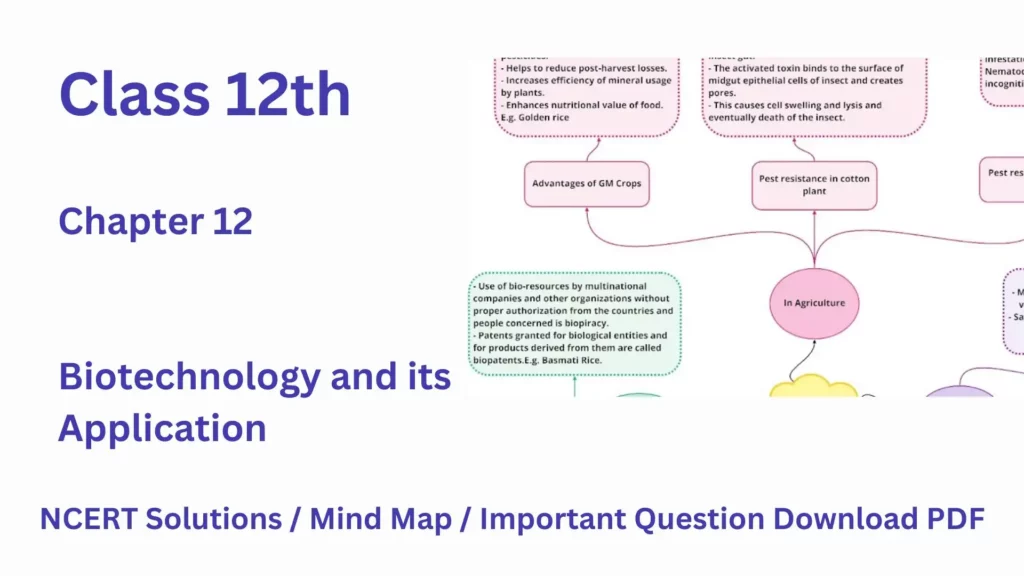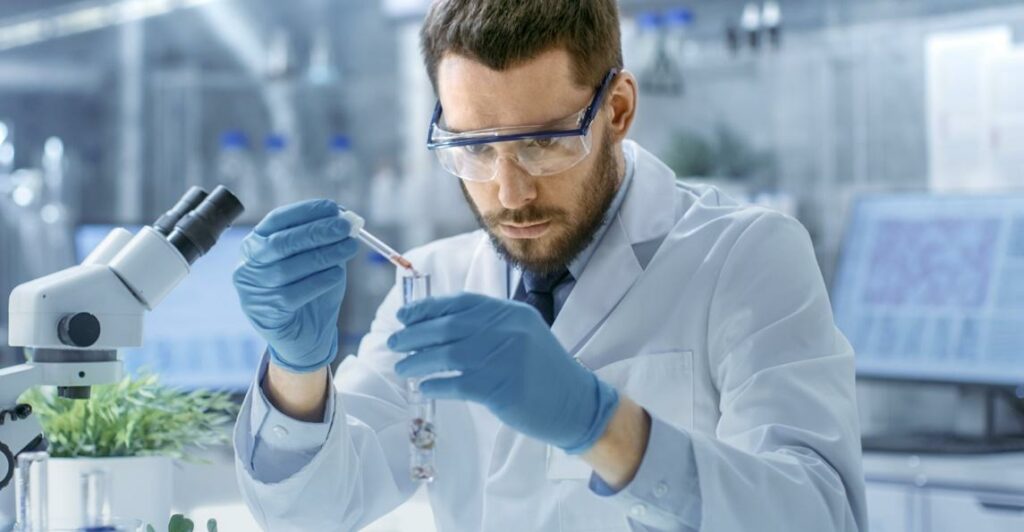NCERT Solutions, Question Answer and Mind Map for Class 12 Biology Chapter 12, “Biotechnology and its Application,” is a comprehensive study material package designed to help students understand the principles and applications of biotechnology.
NCERT Solutions provide detailed explanations and answers to the questions presented in the chapter. The solutions cover all the topics in the chapter, from the tools and techniques of biotechnology to its applications in different fields, such as agriculture, medicine, and industry. They also provide tips on how to answer different types of questions, including short answer, long answer, and multiple-choice questions.

The question-answer section of the chapter covers a wide range of topics, from genetic engineering and DNA fingerprinting to the production of genetically modified crops and recombinant proteins. It also includes questions on the ethical and social implications of biotechnology and the regulations governing its use.
The mind map provides a visual representation of the key topics covered in the chapter, allowing students to understand the connections between different concepts and ideas. The mind map covers the different applications of biotechnology, such as gene therapy, bioremediation, and genetic testing.
NCERT Solution Class 12 Biology Chapter 12 Biotechnology and its Application with Mind Map PDF Download
Biotechnology:
The use of biology to develop technologies and products for the welfare of human beings is known as biotechnology.
It has various applications in different fields such as therapeutics, diagnostics, processed food, waste management, energy production, genetically modified crops, etc.

Biotechnological Application in Agriculture:
- Biotechnology has different applications in agriculture.
- It can be used in agrochemicals, organic agriculture, and genetically engineered crop-based agriculture.
- To produce genetically modified organisms, it can be used. Genetically modified organisms (GMO) can be obtained by alteration in their genetic material.
A different application of genetically modified organisms is:
- Production of crops that are resistant to abiotic factors such as heat, cold, etc.
- Pest-resistant crops.
- Help to reduce post-harvest losses.
- Minerals can be used by the plants efficiently.
- Food with enhanced nutritional values.
Green Revolution:
The Green Revolution succeeded in tripling the food supply but yet it was not enough to feed the growing human population. Increased yields have partly been due to the use of improved crop varieties, but mainly due to the use of better management practices and use of agrochemicals (fertilizers and pesticides). for farmers in the developing world, agrochemicals are often too expensive and further increases in yield with existing varieties are not possible using conventional breeding Use of genetically modified crops is a possible solution.
Bacillus thuringiensis (Bt):
Bt toxin is produced by a bacterium called Bacillus thuringiensis (Bt for short). Bt toxin gene has been cloned from the bacteria and been expressed in plants to provide resistance to insects without the need for insecticides created a bio-pesticide Examples are Bt cotton, Bt corn, rice, tomato, potato and soyabean etc.

Bt Cotton:
Some strains of Bacillus thuringiensis produce proteins that kill certain insects such as lepidopterans (tobacco budworm, armyworm) coleopterans (beetles) and dipterans (flies, mosquitoes). B. thuringiensis forms protein crystals during a particular phase of their growth These crystals contain a toxic insecticidal protein. Bt toxin protein exist as inactive protoxins once the insect ingest the inactive toxin it is converted into an active form of toxin due to alkaline pH of gut which solubilise crystals activated toxin binds to the surface of midgut epithelial cells create pores that cause cell swelling and lysis and eventually cause death of the insect.
Cry:
Specific Bt toxin genes were isolated from Bacillus thuringiensis and incorporated into the several crop plants such as cotton as most Bt toxins are insect-group specific. The toxin is coded by a gene named cry. for example, the proteins encoded by the genes cryIAc and cryIIAb control the cotton bollworms, that of cryIAb controls corn borer.
Pest Resistant Plants:
Various pests affect the plants which cause loss as well as a decrease in the yield of the plant.
A nematode Meloidogyne incognita infects the roots of tobacco plants and causes a decrease in the yield of the plant. To prevent this, RNA interference technology was used. This method involves silencing a specific mRNA due to a complementary dsRNA molecule. This inhibits the translation of the mRNA.
Biotechnological Applications In Medicine:
The rDNA technological processes have made immense impact in the area of healthcare by enabling mass production of safe and more effective therapeutic drugs. At present, about 30 recombinant therapeutics have been approved for human use the world over. In India, 12 of these are presently being marketed.
Genetically Engineered Insulin:
- Adult-onset diabetes can be controlled by taking insulin at regular intervals. The main source of this insulin was isolation of insulin from animals. Now a day’s insulin can be obtained from bacterium using techniques of biotechnology.
- Insulin was earlier extracted from pancreas of slaughtered cattle and pigs but insulin from these sources develops allergy or other types of reactions to the foreign protein.
- Insulin consists of two short polypeptide chains- chain A and chain B, that are linked together by disulphide bridges.
- In humans, insulin is synthesized as a prohormone, which contains an extra stretch called C peptide, which is absent in mature insulin. The main challenge for production of insulin using rDNA technique was getting insulin assembled into a mature form.
- An American company, Eli Lilly in 1983 prepared two DNA sequence corresponding to A and B chain of human insulin and introduced them in plasmids of E.coli to produce insulin chain. Chain A and Chain B were produced separately, extracted and combined by creating disulphide bonds to form human insulin.

Gene Therapy:
- It is a collection of methods that allows correction of a gene defect that has been diagnosed in a child or embryo. This method is applied in a person with a hereditary disease. In this method, genes are inserted into a person’s cells and tissues to treat a disease.
- The correction of gene defect involves delivery of a normal gene into the individual or embryo to take over the function of and compensate for non-functional gene.
- The first clinical gene therapy was done in 1990 to a 4 year old girl with adenosine deaminase (ADA) deficiency. This disorder is caused due to the deletion of the gene for adenosine deaminase that is essential for immune system to function. This defect can be treated by enzyme replacement therapy in which functional ADA is given to the patient by injection or bone marrow transplant.
- In gene therapy method lymphocytes from the blood of the patient are grown in culture medium outside the body. A functional ADA cDNA is then introduced into these lymphocytes and returned to the patient. In this method periodic infusion of such genetically engineered lymphocytes is needed. If gene isolated from bone marrow cells producing ADA is introduced into cells at early embryonic stages, it could be a permanent cure.

Molecular Diagnosis:
Conventional method of diagnosis such as serum or urine analysis is not able to early detection of disease-causing pathogens or virus.
Following methods can be used to diagnosed earlier:
- Recombinant DNA technology.
- Polymerase Chain Reaction (PCR).
- Enzyme Linked Immuno-sorbent Assay (ELISA).
Symptoms of disease appear only when the concentration of pathogen get increased significantly. Low concentration of bacteria and virus can be detected by amplification of nucleic acid by PCR. It detects the mutation in the gene in cancer patient. PCR is routinely used to detect the HIV in suspected AIDS patients. Genetic disorder can be also detected by using PCR technique.
A single stranded DNA or RNA having radioactive molecule is allowed to hybridize to its complementary DNA in a clone of cells followed by detection using autoradiography. The clone having the mutated gene will not appear on the photographic film.
ELISA is based on the principle of antigen-antibody interaction. Infection by pathogen can be detected by the presence of antigens like proteins, glycoproteins etc. or by detecting the antibodies synthesised against the pathogen.
Transgenic Animals:
Transgenic animals can be defined as those animals in which a new or altered gene has been experimentally inserted into the genome by genetic engineering technique.
Few examples of transgenic animals are rats, rabbits, pigs, sheep, cows, fish, etc. Among all other transgenic animals, the mouse is the existing transgenic animal.
The main aim behind the creation of transgenic animals are:
- For the production of biological products.
- To study the different types of diseases.
- To study the contribution of genes in the development of the disease.
- For testing the safety of vaccines and toxicity of drugs before they are used on humans.
- To study how genes are regulated and how do they affect the normal functioning of the body and its development.
Applications in Aquaculture:
Biotechnology applications help in the improvement of quality and quantity of fish. The gonadotropin-releasing hormone is introduced into the fish to enhance breeding. This helps in enhancing growth and improving their genetic characteristics. It also prevents a number of diseases.
Production of Antibiotics:
Biotechnology helps in the production of vaccines, antibiotics and artificial hormones, using plants. Genes with desired characteristics are introduced into the plants to manufacture the encoded proteins. Edible vaccines are cost-effective, can be easily stored and administered in the body. These are used to cure diseases such as measles, hepatitis, cholera, etc.
Ethical Issues:
GEAC (Genetic Engineering Approval Committee): The Indian Government has set up organisations such as GEAC (Genetic Engineering Approval Committee) will make decisions regarding the validity of GM research and the safety of introducing GM-organisms for public services.Biopiracy: The use of bio-resources found in any country by commercial and multinational companies and other organizations without taking appropriate authorization and permission from the countries and their people concerned and also without making the compensatory payment is biopiracy.
NCERT Solution for Class 12 Biology Chapter wise
- Chapter 1 Reproduction in Organisms
- Chapter 2 Sexual Reproduction in Flowering Plants
- Chapter 3 Human Reproduction
- Chapter 4 Reproductive Health
- Chapter 5 Principles of Inheritance and Variation
- Chapter 6 Molecular Basis of Inheritance
- Chapter 7 Evolution
- Chapter 8 Human Health and Disease
- Chapter 9 Strategies for Enhancement in Food Production
- Chapter 10 Microbes in Human Welfare
- Chapter 11 Biotechnology: Principles And Processes
- Chapter 12 Biotechnology and its Applications
- Chapter 13 Organisms and Populations
- Chapter 14 Ecosystem
- Chapter 15 Biodiversity and Conservation
- Chapter 16 Environmental Issues
